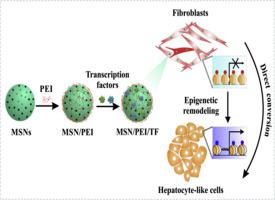当前位置:
X-MOL 学术
›
Mater. Today Chem.
›
论文详情
Our official English website, www.x-mol.net, welcomes your feedback! (Note: you will need to create a separate account there.)
Direct reprogramming of mouse fibroblasts into hepatocyte-like cells by polyethyleneimine-modified nanoparticles through epigenetic activation of hepatic transcription factors
Materials Today Chemistry ( IF 7.3 ) Pub Date : 2020-09-01 , DOI: 10.1016/j.mtchem.2020.100281 M. Wang , J. Yu , L. Cai , X. Yang
Materials Today Chemistry ( IF 7.3 ) Pub Date : 2020-09-01 , DOI: 10.1016/j.mtchem.2020.100281 M. Wang , J. Yu , L. Cai , X. Yang

|
Abstract Direct reprogramming without an intermediate pluripotent state has great therapeutic potential in regenerative medicine. Controlling lineage-specific transcription factors (TFs) expression can change cell fate and plasticity of somatic cells. However, traditional method of direct reprogramming using viral vector mediated gene delivery remains an obstacle for clinical application due to risk of tumorigenesis. Recently, nanomaterials have been reported to be more promising delivery systems to achieve this aim, but most of methods provide DNA-based reprogramming and the underlying mechanism of direct reprogramming remains poorly understood. Here, polyethyleneimine (PEI)-modified silica nanoparticles are developed as an efficient and safe protein transduction platform for delivering two key recombinant proteins of TFs for direct lineage reprogramming of mouse embryonic fibroblasts (MEFs) to functional induced hepatocyte-like cells (iHeps). Furthermore, the mechanisms involved in lineage reprogramming of MEFs into iHeps induced by mesoporous silica nanoparticle/polyethyleneimine/transcription factor (MSN/PEI/TF) nanocomplexes are elucidated. Epigenetic mechanistic investigations uncovered reinforced enrichment of activating marks (H3K4me3 and H3K9Ac) and loss of repressive marks (H3K27me3 and H3K9me3) at the promoters of hepatic TFs during direct hepatic reprogramming upon PEI-modified silica nanoparticles. Thus, this study provides proof of principle for silica-based nanoparticles as potentially viable and safe therapeutic strategies for direct reprogramming in regenerative medicine.
中文翻译:

聚乙烯亚胺修饰的纳米颗粒通过肝转录因子的表观遗传激活将小鼠成纤维细胞直接重编程为肝细胞样细胞
摘要 没有中间多能状态的直接重编程在再生医学中具有巨大的治疗潜力。控制谱系特异性转录因子 (TF) 的表达可以改变体细胞的细胞命运和可塑性。然而,由于肿瘤发生的风险,使用病毒载体介导的基因递送的直接重编程的传统方法仍然是临床应用的障碍。最近,据报道纳米材料是实现这一目标的更有希望的传递系统,但大多数方法提供基于 DNA 的重编程,而直接重编程的潜在机制仍然知之甚少。这里,聚乙烯亚胺 (PEI) 修饰的二氧化硅纳米粒子被开发为一种有效且安全的蛋白质转导平台,用于提供两种关键的 TF 重组蛋白,用于将小鼠胚胎成纤维细胞 (MEF) 直接谱系重编程为功能性诱导肝细胞样细胞 (iHeps)。此外,阐明了介孔二氧化硅纳米颗粒/聚乙烯亚胺/转录因子 (MSN/PEI/TF) 纳米复合物诱导 MEF 谱系重编程为 iHeps 的机制。表观遗传机制研究发现,在对 PEI 修饰的二氧化硅纳米粒子进行直接肝重编程期间,激活标记(H3K4me3 和 H3K9Ac)的强化富集和肝 TF 启动子处的抑制标记(H3K27me3 和 H3K9me3)的丢失。因此,
更新日期:2020-09-01
中文翻译:

聚乙烯亚胺修饰的纳米颗粒通过肝转录因子的表观遗传激活将小鼠成纤维细胞直接重编程为肝细胞样细胞
摘要 没有中间多能状态的直接重编程在再生医学中具有巨大的治疗潜力。控制谱系特异性转录因子 (TF) 的表达可以改变体细胞的细胞命运和可塑性。然而,由于肿瘤发生的风险,使用病毒载体介导的基因递送的直接重编程的传统方法仍然是临床应用的障碍。最近,据报道纳米材料是实现这一目标的更有希望的传递系统,但大多数方法提供基于 DNA 的重编程,而直接重编程的潜在机制仍然知之甚少。这里,聚乙烯亚胺 (PEI) 修饰的二氧化硅纳米粒子被开发为一种有效且安全的蛋白质转导平台,用于提供两种关键的 TF 重组蛋白,用于将小鼠胚胎成纤维细胞 (MEF) 直接谱系重编程为功能性诱导肝细胞样细胞 (iHeps)。此外,阐明了介孔二氧化硅纳米颗粒/聚乙烯亚胺/转录因子 (MSN/PEI/TF) 纳米复合物诱导 MEF 谱系重编程为 iHeps 的机制。表观遗传机制研究发现,在对 PEI 修饰的二氧化硅纳米粒子进行直接肝重编程期间,激活标记(H3K4me3 和 H3K9Ac)的强化富集和肝 TF 启动子处的抑制标记(H3K27me3 和 H3K9me3)的丢失。因此,


























 京公网安备 11010802027423号
京公网安备 11010802027423号